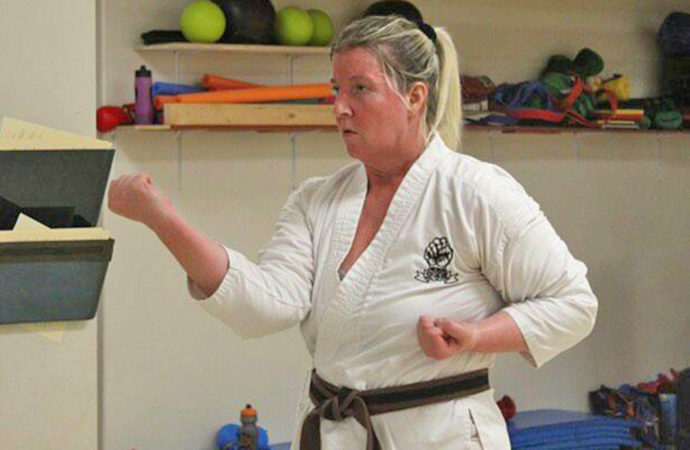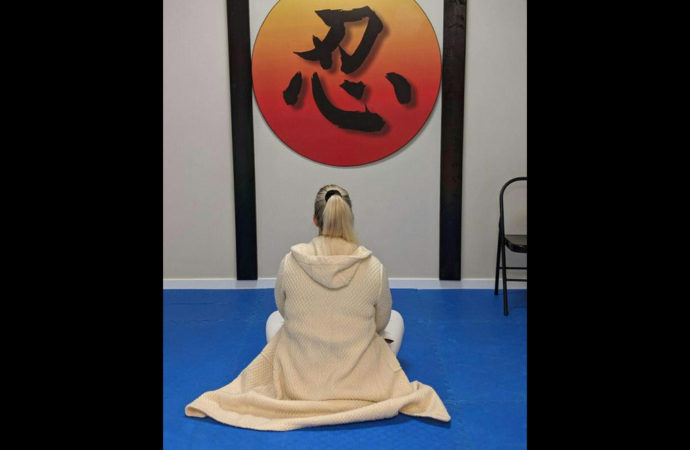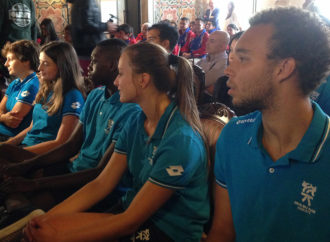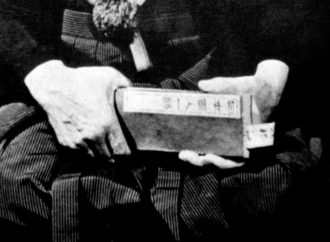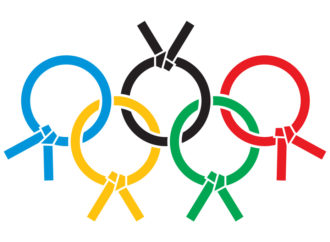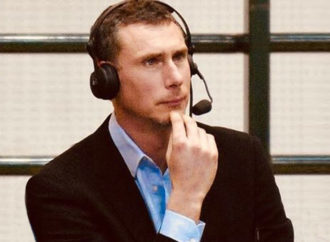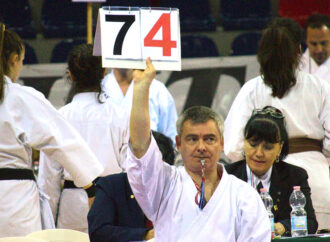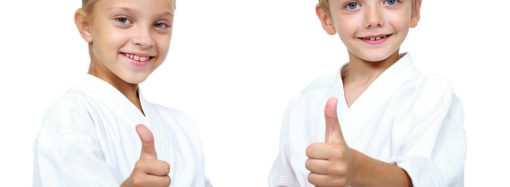Vi raccontiamo la storia di un’insegnante canadese protagonista di una svolta esistenziale radicale ed esempio di rinascita.
(English version below)
Chissà se la protagonista di questa intervista ha mai sussurrato tra sé parole simili a quelle scritte da Franco Battiato nel testo di Un’altra vita…
Di sicuro le ha tradotte in pratica con coraggio, passando dal ruolo di affermata manager a quello d’insegnante di karate e di yoga, guadagnandoci un’esistenza felice e piena di significato. Ci ha spiegato come ha cambiato vita, dedicandosi a ciò che ama di più.
Ve la presentiamo: Katherine Lynn Good, classe 1971, vive nella zona occidentale del Canada.
Posso usare lo yoga per aiutare gli studenti ad affinare posizioni, tecniche, movimenti e kata per raggiungere livelli più elevati di prestazione.
Benvenuta Katherine, ci dai qualche flash sulla tua infanzia e adolescenza?
Sono nata a Calgary, ma all’età di 5 anni mi sono trasferita con la famiglia nella piccola comunità rurale di Balzac, nella contea di Alberta. Lì ho trascorso infanzia e adolescenza. Ho amato molto quel posto tranquillo, quando si cresce in mezzo alle praterie bisogna ingegnarsi, non c’è molto da fare e gli amici spesso non sono vicino a te. Perciò, è importante riuscire a essere indipendenti e creativi.
Che percorso di studi hai seguito?
Mi sono indirizzata al commercio. Nel ’94 mi sono laureata a Calgary, poi ho proseguito gli studi in Francia, dove ho conseguito il Master in Business Administration [Seconda del suo corso, complimenti Katherine! nda]
Conoscevi già allora il karate e lo yoga?
Oh no, non facevo sport da piccola, né yoga. L’unico che ho provato è stato il basket quando avevo tra gli 11 e i 12 anni, prima coi ragazzi e poi con le ragazze. Ero brava, ma alla lunga ho perso interesse.
Passiamo a Katherine adulta: finiti gli studi, come e dove hai cominciato a lavorare?
Mi viene da sorridere a questa domanda, è una storia lunga… Dopo l’università mi sono messa in proprio. La mia ditta, la Lakusta Energy Service, vendeva compressori alle aziende produttrici di petrolio e gas di Alberta. Dal ’94 ho lavorato a tempo pieno come presidente della compagnia per 24 anni, diventandone poi l’unica proprietaria. Mi piaceva collaborare con le persone, ma il lavoro in sé non era adatto a me. La pressione per consegnare i prodotti in tempo era enorme. Ogni giorno era necessario “correre”, ogni contatto era cruciale e tutto ciò si traduceva in stress per il corpo, la mente, lo spirito. Però, ho imparato molto da quel lavoro, in termini di gestione, di relazioni, anche un approccio mentale sistematico che poi ho portato nel mio metodo di insegnamento di karate e yoga.
Contemporaneamente praticavi arti marziali?
Negli anni 2000 non potevo, ho messo al mondo tre figli. La compagnia progrediva e io dormivo sempre meno. Stressata com’ero, era impossibile andare avanti. Così, nel 2007 mi sono decisa a provare lo yoga, per tentare di rilassarmi e di dormire meglio.
Ti è mai capitato di gareggiare?
Non ho mai gareggiato, ma ho trascorso tanto tempo in “competizione” con me stessa… Spingermi a migliorare in tutti gli aspetti della mia vita è ormai un’abitudine consolidata. Le gare contro gli altri non mi interessano, non c’è gioia in questo, per me.
Ma le competizioni ti piacciono?
Sì e apprezzo ciò che la competizione può fare per costruire il carattere di chi vi partecipa. Tutti i miei figli hanno gareggiato nel karate e nel kobudo e hanno imparato a essere buoni, gentili e solidali. Sono cresciuti sani. Sono molto grata a chi organizza tornei per bambini, che così si abituano a impostare e a raggiungere i propri obiettivi.
Quindi, t’interessa di più l’aspetto filosofico e formativo della disciplina?
Sì, sono più interessata alla filosofia e alla forma del karate. Ho iniziato con le arti marziali nel 2011, sperando di trovare un terreno comune con lo yoga. Mi sono sorpresa nel constatare che il karate non era l’opposto dello yoga. Entrambe le discipline hanno un principio di fondo che unisce corpo, mente e spirito. Alcune delle forme sono così simili che danno sicuramente la prova moderna delle teorie storiche di Bodhidharma.
Arriviamo alla “svolta”. Quando e come hai deciso che la vita di prima non bastava più?
Una notte di maggio del 2013, seduta sul pavimento nell’angolo più nascosto della zona di allenamento di Shima Karate Dojo Nanaimo, stavo guardando una parete vuota mentre facevo stretchng ed ero sopraffatta dal desiderio di una vita semplice.
È stato un momento potente… Sembrava che ci fossero increspature nell’energia intorno a me… come quando una pietra viene gettata in uno stagno. Questo istante ha cambiato il modo in cui prendo le decisioni e la forza trainante è sempre stata il desiderio di una vita semplice. Il mio obiettivo è quello di vivere in semplice abbondanza attraverso un servizio sostenibile.
Sto sviluppando un seminario da offrire ai dojo di tutto il mondo, per condividere la conoscenza dei principi dello yoga applicati al karate.
La scelta di lavorare nel mondo delle arti marziali è stata naturale?
Sì, molto naturale. Il mio lavoro nel petrolio e nel gas mi ha insegnato a pensare sistematicamente. Avevo trascorso due anni, fra 2011 e 2013, guardando i corpi umani di oggi che eseguono kata di karate sviluppati oltre cento anni fa, ma il corpo umano moderno è diverso da quello del tempo in cui i kata sono stati ideati. Ciò è dovuto in gran parte ai cambiamenti nel lavoro, nella cultura, nella dieta e nei trasporti.
Il mio scopo era quello d’insegnare pose di yoga mirate agli allievi di karate, per attrezzare meglio i loro corpi a effettuare le posizioni tradizionali, le tecniche e i kata, con l’allineamento migliore delle articolazioni. Il tutto studiato per permettere loro di praticare per più anni, con meno dolore generale, minore usura e maggiore longevità delle articolazioni.
Nel corso del tempo le mie abilità si sono evolute tanto che posso usare lo yoga per aiutare gli studenti ad affinare posizioni, tecniche, movimenti e kata per raggiungere livelli più elevati di prestazioni. Questa messa a punto si basa sulla dinamica corporea di ogni individuo e sulla relazione con la forza di gravità.
Hai incontrato difficoltà nel realizzare il tuo progetto? Come le hai superate?
Mi viene da sorridere… Comunque, il più grande ostacolo era nella mia testa. Ogni giorno la mia mente mi chiedeva: “Che cosa stai facendo? Come farai a pagare le bollette? Sei pazza?” e ogni giorno mi sono detta: vai avanti. Continua a provarci. Non arrenderti!
Avevo bisogno di un mantra e il mio mantra è diventato: “Voglio vivere una vita di servizio sostenibile”. Il servizio è per gli altri esseri umani, per aiutarli a utilizzare meglio i loro corpi. Infatti, quando il corpo è utilizzato con l’allineamento delle articolazioni, il dolore diminuisce e ciò si traduce in più pace nel corpo, nella mente, nello spirito. Poi, migliorare la capacità di sollevare peso contro la gravità, porta un fondamento più solido per la persona e permette un movimento migliore e un generale benessere.
La parola “sostenibile” significa essere in grado di pagare le bollette… Ora ho diversi sbocchi in cui realizzare il mio servizio sostenibile. Sensei Kurt Nordli di Shima Karate Dojo Nanaimo è stato molto favorevole all’introduzione dello yoga nel dojo, creando per me un bellissimo spazio per insegnarlo. Ho studenti da 8 a 56 anni, che vanno dalla cintura bianca al 5° Dan cintura nera. Ho insegnato ad allievi provenienti da Canada, Brasile e Italia. Inoltre, do lezioni private di yoga nella mia abitazione sulla spiaggia e lì gli studenti imparano a usare meglio il proprio corpo in classi su misura per le proprie specifiche esigenze. [Le sessioni si svolgono all’interno della casa che ha grandi vetrate con vista sull’Oceano… che meraviglia! nda].
Tengo anche un corso per aziende e organizzazioni. Si tratta di un’ora in cui spiego alle persone a come usare meglio il corpo e come applicare i principi dello yoga nella loro vita quotidiana. Ho tenuto questo corso presso le principali imprese canadesi.
Questo autunno abbiamo iniziato anche corsi di autodifesa, con sessioni di 10 minuti all’interno di ogni lezione del venerdì.
Infine, sto sviluppando un seminario da offrire ai dojo di tutto il mondo, per condividere la conoscenza dei principi dello yoga applicati al karate.
Hai avuto problemi a conciliare la gestione della famiglia con l’attività nel karate?
Sì, ci sono stati problemi, ma preferisco vederli come opportunità di apprendimento. Nella mia carriera precedente, i miei figli erano bambini privilegiati che hanno viaggiato molto, hanno sempre avuto nuovi libri, vestiti, qualunque cosa volessero. Il denaro non era un problema. Poi il reddito è diminuito, i bambini l’hanno notato e si sono adattati.
Uno dei miei figli aveva paura. Era difficile vederlo avere tanta paura e sapere che le mie scelte ne erano la causa. Oggi, lui capisce che il mio servizio sta diventando sempre più sostenibile e mi pone meno frequentemente la domanda: “Sarà tutto ok?”.
Gli altri due figli sono diventati molto parsimoniosi! Risparmiano, spendono i soldi saggiamente, creano opportunità imprenditoriali, fanno acquisti nei negozi dell’usato e cercano di non sprecare nulla. È stato un piacere vederli imparare ad adattarsi a nuovi modi di vivere. Anche mio marito e io abbiamo imparato ad adattarci… per esempio, usando una sola auto. E stiamo facendo da soli i lavori per la casa, invece di pagare ditte esterne. Mio marito è il mio miglior supporto, il baby sitter e il cuoco dei ragazzi e li porta dovunque. Lavora come tuttofare per integrare il nostro reddito. Il suo commento quando ho deciso di cambiare carriera è stato: fai qualsiasi cosa che ti renda felice. Sii te stessa.
Passiamo al cuore della tua attività, che è essenzialmente rivolta alle donne, al loro benessere, alla loro crescita personale in fiducia e sicurezza. Ce la puoi illustrare?
La Shima Karate Dojo Ladies’ karate and yoga class è una comunità di donne da 15-56 anni, da cintura bianca a cintura nera, che si riuniscono ogni venerdì sera per imparare ad applicare i principi dello yoga al karate e alla vita. Le studentesse sono per lo più le mamme che stavano sedute nell’atrio del dojo, aspettando che i loro figli finissero l’allenamento. Sono donne che pensavano che il karate non fosse per loro. Adesso si sfidano in kata, sparring e kata di squadra. La nostra etica di classe ufficiale è “sostenersi l’un l’altra attraverso l’amore e la gentilezza per essere il meglio che possiamo essere: corpo, mente e spirito. Con la volontà di ridurre il nostro ego e ricominciare, in ogni classe”. La filosofia della classe si fonda su una frase del XIV Dalai Lama, secondo la quale attraverso la pace interiore si può raggiungere una vera pace nel mondo. L’importanza della responsabilità individuale è chiara, perché un’atmosfera di pace deve essere creata dentro di sé, così arriverà nella famiglia e poi nella comunità.
La nostra etica di classe ufficiale è “sostenersi l’un l’altra attraverso l’amore e la gentilezza per essere il meglio che possiamo essere: corpo, mente e spirito.”
C’è un sogno legato al karate che coltivi per te e per la comunità di donne che segui?
Questa domanda mi ha fatto venire le lacrime agli occhi. Ho iniziato karate con un corpo inadatto e ansia nella mia mente. E quasi nove anni dopo, mi sono guadagnata una cintura nera.
Il mio più grande sogno è per le donne sedute nelle sale d’attesa, perché sappiano che il karate è anche per loro. Auguro alle signore e alle mamme il coraggio di fare il primo passo attraverso la porta del dojo.
Il mio sogno personale nel karate è poliedrico, io voglio: continuare a essere un’operatrice di servizio sostenibile attraverso l’insegnamento di yoga e karate; continuare a spiegare i principi dello yoga agli studenti di karate di tutto il mondo, per permettere loro di fare karate per più anni con meno dolore; continuare ad aiutare tutti gli esseri umani a imparare a come usare meglio i loro corpi nella vita quotidiana e continuare a studiare le infinite, affascinanti sovrapposizioni di karate e yoga.
Infine, Katherine, che cos’è per te il cambiamento?
Il nome del mio brand di yoga è “Radici e le ali Yoga”. Nella vita abbiamo bisogno sia delle radici sia delle ali, perché tutto cambia, sempre. Il cambiamento fa parte della natura. La chiave è come lo affrontiamo fuori e dentro di noi.
Yoga e karate ci danno una base, da cui possiamo spiegare le nostre ali e volare indisturbati dai venti del cambiamento, che soffierà sempre. Yoga e karate ci danno radici attraverso la loro capacità di portare equilibrio ai nostri corpi, menti e spiriti. Ciò conduce alla pace interiore e alla conoscenza di noi stessi. E io ne sono sempre grata, perché ha fatto tutta la differenza del mondo per me.
Katherine, the woman who lived twice
We tell you the story of a Canadian teacher protagonist of a radical existential turning point and example of rebirth.
One wonders if the protagonist of this interview has ever whispered to herself words similar to the lyrics written by Franco Battiato in “Another life…”. She has certainly put them into practice with courage, going from the role of an established manager to that of a karate and yoga teacher, gaining a happy and meaningful existence. She told us how she have changed her life, choosing to devote herself to what she loves most. Her name is Katherine Lynn Good, she is 48 years old and lives in the western side of Canada.
My purpose was to teach targeted yoga poses to karate students, to better equip their bodies to maintain traditional positions, techniques and kata with better alignment of joints.
Katherine welcome, let’s start with some flashes about your childhood and adolescence.
I was born in Calgary, but at the age of 5 I moved with the family to the small rural community of Balzac, Alberta County. I spent my childhood and adolescence there. I loved that quiet place. When you grow up in the middle of the grasslands, you must endeavor, there’s not much to do and friends are often not close to you. Therefore it is important to be independent and creative.
What course of study did you follow?
I have addressed myself to trade. In 1994 I graduated in Calgary, then I continued my studies in France, where I obtained the master’s in business administration – MBA. [Second of her course, congratulations Katherine! author’s note].
Did you know karate and yoga then?
Oh no, I didn’t play sports as a child, nor yoga… the only thing I tried was basketball, when I was between 11 and 12 years old, first with boys and then with girls. I was excellent, but in the long run I lost interest.
Let’s go to Katherine adult; finished your studies, how and where did you start working? Did you like it?
I smile at this question, it’s a long story… After university I started my own business. My company, Lakusta Energy Service, sold compressors to the oil and gas companies in Alberta. Since ’94 I have worked full-time as president of the company for 24 years, then becoming the sole owner. I liked collaborating with people, but the work itself was not suitable for me. The pressure to deliver products on time was huge. Every day it was necessary to run, every contact was crucial, and all this resulted in stress for the body, the mind, the spirit. But I learned a lot from that work, in terms of management, relationships, also a systematic mental approach – which I then brought into my method of teaching karate and yoga.”
Did you practice martial arts at the same time?
In the 2000s I couldn’t, I gave birth to three children. The company progressed, and I slept less and less. As stressed as I was, it was impossible to go on. So in 2007 I decided to try yoga, to try to relax and sleep better.
Have you ever competed?
I’ve never competed. I’ve spent so much time competing with myself… pushing myself to improve in all aspects of my life, it’s a long-established habit. I don’t care about competition against other people. There is no joy in this, for me.
But competitions, do you like them?
Oh yes, and I appreciate what the competition can do to build the character of those who participate. All my children have competed in karate and kobudo and have learned to be good, kind and supportive. They grew up healthy. I am very grateful to those who organize tournaments for children, so they get used to setting and achieving their goals.
So you’re more interested in the philosophical and formative aspect of discipline?
Yes, I’m more interested in the philosophy and form of karate. I started with martial arts in 2011, hoping to find common ground with yoga.I was surprised to see that karate was not the opposite of yoga. Both disciplines have a basic principle that unites body, mind and spirit. Some of the forms are so similar that they surely give modern proof of Bodhidharma’s historical theories.
Let’s get to the turning point. When and how did you decide that life wasn’t enough?
One night in May 2013, sitting on the floor in the most hidden corner of Shima Karate Dojo Nanaimo’s training area, I was looking at an empty wall while stretching, and I was overwhelmed by the desire for a simple life. It was a powerful moment… It seemed that there were ripples in the energy around me… like when a stone is thrown into a pond. This moment has changed the way I make decisions, and the driving force has always been the desire for a simple life. My goal is to live in abundance.
I am developing a seminar to offer to dojos around the world, to share knowledge of the principles of yoga applied to karate.
Was the decision to work in the martial arts natural?
Yes, very natural. My work in oil and gas has taught me to think systemati-cally. I had spent 2 years, between 2011 and 2013, looking at today’s hu-man bodies performing karate kata developed over 100 years ago. But the modern human body is different from that of the time when the kata were conceived. This is largely due to changes in work, culture, diet and transport. My purpose was to teach targeted yoga poses to karate students, to better equip their bodies to maintain traditional positions, techniques and kata with better alignment of joints. All designed to allow him to practice for several years with less general pain, less wear and more longevity of the joints.
Over time, my skills have evolved so much that I can use yoga to help stu-dents hone positions, techniques, movements and kata to achieve higher levels of performance. This development is based on the bodily dynamics of each individual and the relationship with the force of gravity.
Have you encountered difficulties in carrying out your project? How did you get past them?
Even here, it makes me smile… Anyway, the biggest obstacle was in my head. Every day my mind asked me: “What are you doing? How are you gonna pay the bills? You’re crazy?” Every day I said to myself: go on. Keep trying to. Don’t give up. I needed to get a mantra. My mantra has become: “I want to live a life of sustainable service”. The service is for other human beings, to help them make better use of their bodies. In fact, when the body is used with the alignment of the joints, the pain decreases and this results in more peace in the body, mind, spirit. Then improve the ability to lift weight against gravity, brings a firmer foundation to the person, and allows for better movement and general well-being. The word “sustainable” means being able to pay the bills…
Now I have several outlets where to achieve my sustainable service. Sensei Kurt Nordli of Shima Karate Dojo Nanaimo was very favorable to the introduc-tion of yoga in the dojo. He created a beautiful space for me to teach. I have students from 8 to 56 years of age, ranging from the white belt to the 5th Dan black belt. I taught students from Canada, Brazil and Italy. I also give private yoga lessons at my beach house, where students learn to use their bodies bet-ter in tailor-made classes for their specific needs.
The sessions take place inside the house which has large windows overlooking the Ocean – what a wonder Katherine!
I also hold a course for companies and organizations.This is an hour in which I explain to people how to use their body better and how to apply the principles of yoga in their daily lives. I took this course at the leading Canadian companies.
We started selfe defences course also, with 10-minute sessions within each Friday lesson.
Finally, I am developing a seminar to offer to dojos around the world, to share knowledge of the principles of yoga applied to karate.
Have you had any problems reconciling family management with the karate business?
Yes, there have been problems, but I prefer to see them as learning opportu-nities.
In my previous career, my children were privileged children who traveled a lot, they always had new books, clothes, whatever they wanted. Money was no problem. Then the income went down. The children noticed it and adapted. One of my children was afraid. It was hard to see him being so afraid and knowing that my choices were the cause. Today, he understands that my ser-vice is becoming more and more sustainable, and asks me less frequently the question: “It will be all right?”.
The other two children have become very thrifty! They save, spend money wisely, create business opportunities, shop in thrift stores and try not to waste anything. It was a pleasure to see them learn to adapt to new ways of life. Even my husband and I have learned to adapt to… for example, using only one car. And we’re doing housework ourselves instead of paying off outside firms. My husband is my best support, the babysitter and the children’s cook, and he takes them everywhere. He works as a handyman to supplement our income. His comment when I decided to change careers was: Do whatever makes you happy. Just be yourself.
Let’s move on to the heart of your business, which is essentially aimed at women, their well-being, their personal growth in confidence and security. Can you explain it to us?
The Shima Karate Dojo Ladies’ karate and yoga class is a community of women from 15-56 years, from white belt to black belt, who gather every Fri-day night to learn how to apply the principles of yoga to karate and life. Stu-dents are mostly moms sitting in the dojo lobby waiting for their children to finish their training. They’re women who thought karate wasn’t for them. Now they compete in kata, sparring and team kata. Our official class ethic is “supporting each other through love and kindness to be the best we can be: body, mind and spirit. With the will to reduce our ego and start over, in each class”. The philosophy of the class is based on a phrase from the 14th Dalai Lama, ac-cording to which true peace in the world can be achieved through inner peace. The importance of individual responsibility is clear, because an atmosphere of peace must be created within itself, so it will arrive in the family and then in the community.
Our official class ethic is “supporting each other through love and kindness to be the best we can be: body, mind and spirit.
Is there a karate dream that you nurture for you and the community of women you follow?
This question brought tears to my eyes…
I started karate with an unfit body and anxiety in my mind. And almost nine years later, I earned a black belt.
My biggest dream is for women in waiting rooms to know that karate is also for them. I wish the ladies and mothers the courage to take the first step through the dojo door.
My personal dream in karate is polyhedral, because I want: continue to be a sustainable service operator through the teaching of yoga and karate; continue to explain yoga principles to karate students around the world, to allow them to karate for more years with less pain; continue to help all human beings learn how to better use their bodies in their daily lives, and continue to study the endless, fascinating overlaps of karate and yoga.
Finally, Katherine, what is change for you?
The name of my yoga brand is “Roots and Yoga wings”. We need both roots and wings in life because everything changes, always. Change is part of na-ture. The key is how we deal with it inside and out. Yoga and karate give us a base, from which we can spread our wings and fly undisturbed by the winds of change, which will always blow. Yoga and karate give us roots through their ability to bring balance to our bodies, minds and spirits. This leads to inner peace and self-knowledge. And I’m always grateful, because it made all the difference in the world for me.







